#Atari 800
Explore tagged Tumblr posts
Text

Atari 400 & Atari 800
#Atari 400#Atari 800#1979#Atari#retro tech#retro gaming#80s#80s aesthetic#retrowave#old tech#techcore#80s tech#80s nostalgia#retro aesthetic#retro ads#synthwave#vaporwave#retro computing#1980s#vintage
3K notes
·
View notes
Text

Maxell computer tape for saving programs
538 notes
·
View notes
Text

Atari 400 and 800 home computers
233 notes
·
View notes
Text

1983
238 notes
·
View notes
Text

1982 Atari 800 ad
#atari#atari 800#1982#1980s#computer#computing#vintage#ad#ads#advertising#advertisement#vintage ad#vintage ads#vintage advertising#vintage advertisement
109 notes
·
View notes
Text

Recreational Computing September-October 1979
An article apiece for the new Texas Instruments TI-99/4 and Atari 800 appeared in this issue, along with plenty of coverage for the Apple II, Commodore PET, and TRS-80 and pieces on more general computing.
4 notes
·
View notes
Text
The Manes-Somerson BASIC Type-In Books (Books, Stephen Manes & Paul Somerson, 1984)
You can read them here.
Co-created by the creator of How to Be a Perfect Person in Just Three Days.

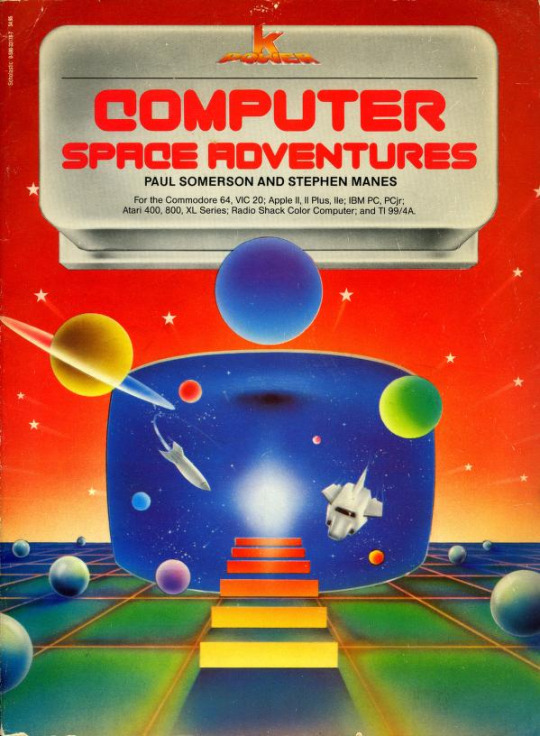
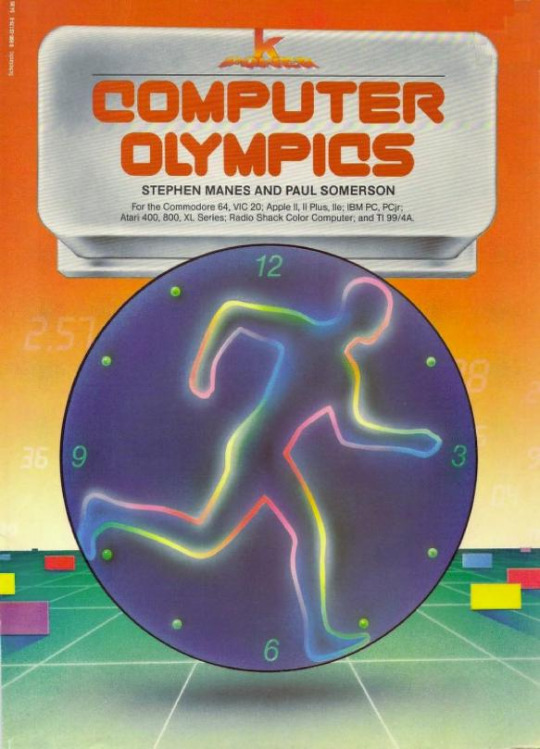

#internet archive#book#books#computer history#computing history#retro computing#basic#c64#commodore 64#vic 20#apple ii#apple 2#atari 400#atari 800#atari 8 bit#1984#1980s#80s
22 notes
·
View notes
Text

Atari BASIC cartridge photograph by Jacob Joaquin
30 notes
·
View notes
Text
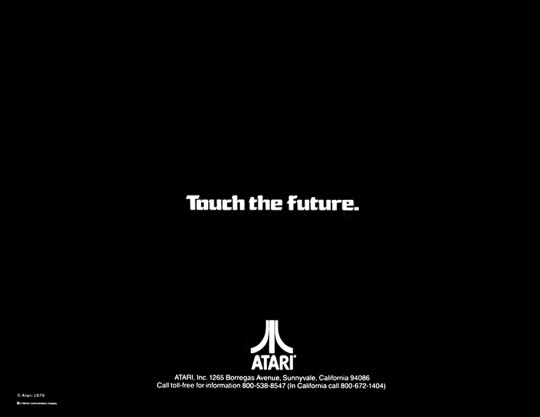
Touch the future. Atari computer ad - 1979.
#vintage advertising#atari#atari computers#atari 400#atari 800#8-bit home computers#atari 8-bit computers#vintage electronics#vintage computers#vintage computing#the 70s#1979#home computer
22 notes
·
View notes
Text
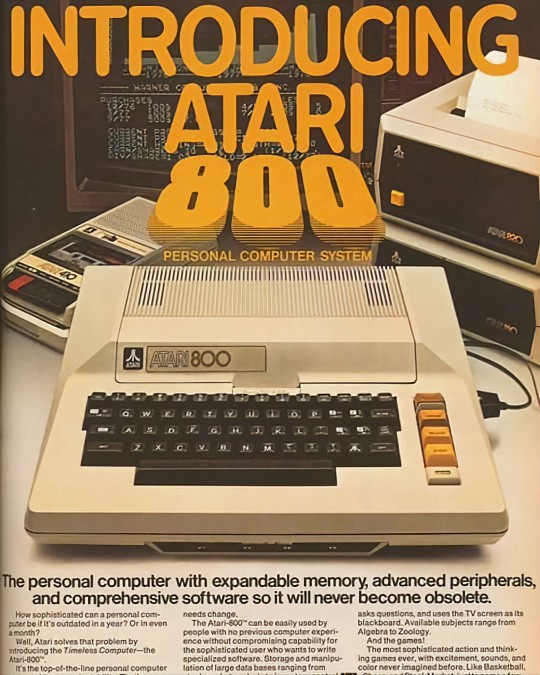
18 notes
·
View notes
Text

"Heaven" From Dandy - John Howard Palevich - Atari 8-bit computers (1983)
4 notes
·
View notes
Text
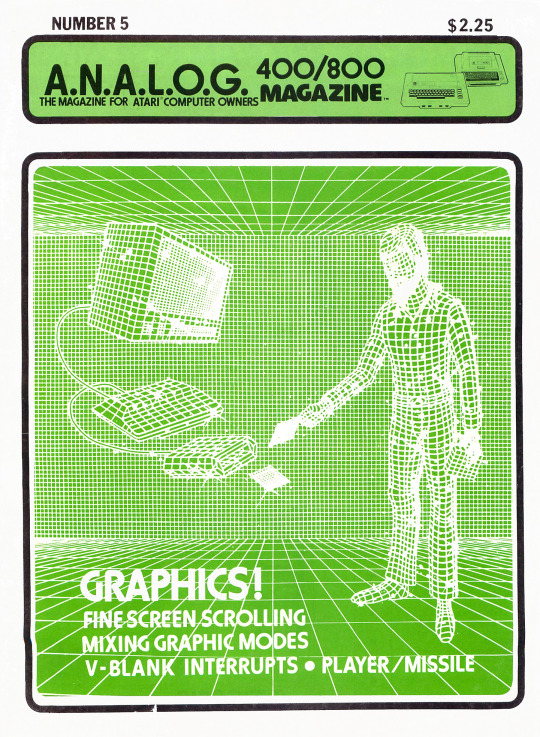
Atari A.N.A.L.O.G. Magazine - No. 5 (1982)
#Atari ANALOG Magazine#Atari#Atari 400#Atari 800#retro computing#retro magazines#computer magazine#retrowave#retro futurism#80s tech#techcore#green
341 notes
·
View notes
Text
instagram
#atari#video games#retro#retro aesthetic#80s aesthetic#vaporwave#retrowave#80s nostalgia#atari vcs#atari st#atari 7800#retro gaming#atari 2600#retro games#arcade#Atari 400#Atari 800#1979#Atari#retro tech#80s#old tech#techcore#80s tech#retro ads#synthwave#retro computing#1980s#vintage#Instagram
3 notes
·
View notes
Text
youtube
Warhawk theme, Atari 8-bit music by the legendary Rob Hubbard. One of my favourites!
11 notes
·
View notes
Text

Electronic Art's "MULE" for the Atari 400/800/1200 computer
Released in 1983 by Electronic Arts for the Atari 400/800, "M.U.L.E." is a seminal video game that combines elements of strategy, resource management, and economic simulation in a multiplayer format. Designed by Dan Bunten (later Danielle Bunten Berry) of Ozark Softscape, "M.U.L.E." is recognized not only for its innovative gameplay but also for fostering social interaction and strategic thinking among players. It remains a beloved classic for its pioneering approach to multiplayer gaming and its enduring game design principles.
Historical Context
The early 1980s marked a vibrant period for the home computer market, with the Atari 400/800 series emerging as significant platforms due to their advanced graphic and sound capabilities relative to competitors. This era witnessed the rise of software companies eager to explore these new technologies, among them Electronic Arts, which was founded with the vision of supporting software developers as artists. "M.U.L.E." was among the first titles released under this new banner, exemplifying the company's commitment to innovative and thoughtful game design.
Gameplay and Design
"M.U.L.E." allows up to four players to colonize a distant planet, competing and cooperating to manage the allocation of resources such as food, energy, smithore (used to make MULEs—Multiple Use Labor Elements), and crystite. The gameplay involves strategic placement of MULEs on various plots of land to harvest resources, which are then used to sustain the colony and can be bought or sold in a dynamic marketplace that simulates supply and demand economics.
One of the most innovative aspects of "M.U.L.E." is its emphasis on economic principles, making it one of the first games to incorporate complex economic algorithms that impact player decisions. It also promotes social interaction through its auction system, where players negotiate and trade resources, requiring real-time decision-making that enhances the game’s dynamic feel.
Technological Innovations
"M.U.L.E." was technologically significant for several reasons. Firstly, its graphic design was highly effective yet simple, with clear, colorful representations of the game world that made complex information accessible and engaging. The user interface was ahead of its time, providing players with easy navigation and management of in-game actions, which was crucial for a game with such depth.
Secondly, the game made excellent use of the Atari 400/800's capabilities, particularly in handling multiple players in a turn-based setting without sacrificing pace or engagement. This was a remarkable achievement that set a precedent for future multiplayer games.
Cultural Impact and Legacy
"M.U.L.E." is beloved by those who played it for several reasons. It was one of the first games to effectively blend competitive and cooperative gameplay, creating a unique social experience in video gaming. The game's ability to forge a communal spirit among players, coupled with the intellectual challenge of managing economic variables, made it not only fun but a mentally stimulating experience.
The game's influence extends beyond just gameplay; it is cited as an inspiration by numerous game developers who appreciated its balanced game mechanics and economic simulation aspects. "M.U.L.E." laid the groundwork for many future simulations and strategy games, and its principles can be seen in modern titles that incorporate complex economic systems and multiplayer components.
Conclusion
"M.U.L.E." remains a landmark in video game history, notable for its innovative approach to gameplay, technology, and social gaming dynamics. It stands out not only as a product of its time but also as a forward-thinking creation that predicted and shaped future developments in the gaming industry. For many, "M.U.L.E." was more than just a game; it was a compelling social and strategic experience that has endured in memory and influence, continuing to inspire game designers and players alike with its timeless design and gameplay.
#EA#Electronic Arts#Trip Hawkins#Atari#Atari 400#Atari 800#Atari 1200#MULE#Retro#Game#Retro game#Retro gaming#Pixel Crisis
4 notes
·
View notes
Text
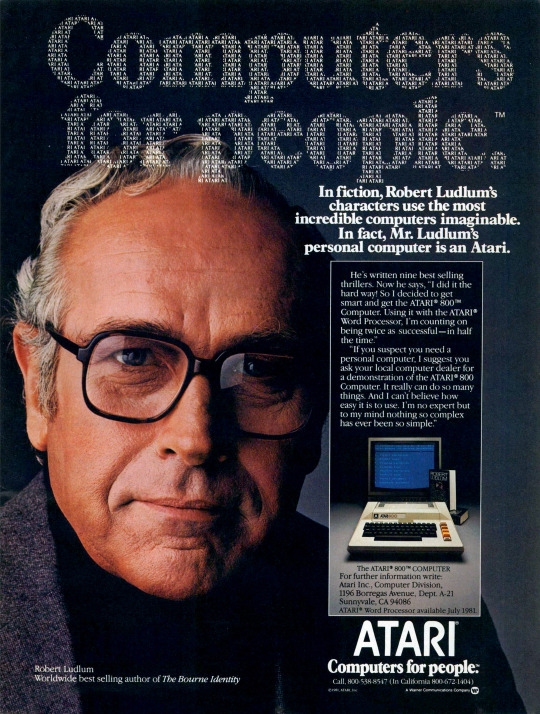
Robert Ludlum for Atari, 1981 ad
#robert ludlum#atari#1981#1980s#atari 800#computer#computing#vintage ocmputer#vintage#ad#ads#advertising#advertisement#vintage ad#vintage ads#vintage advertising#vintage advertisement
60 notes
·
View notes